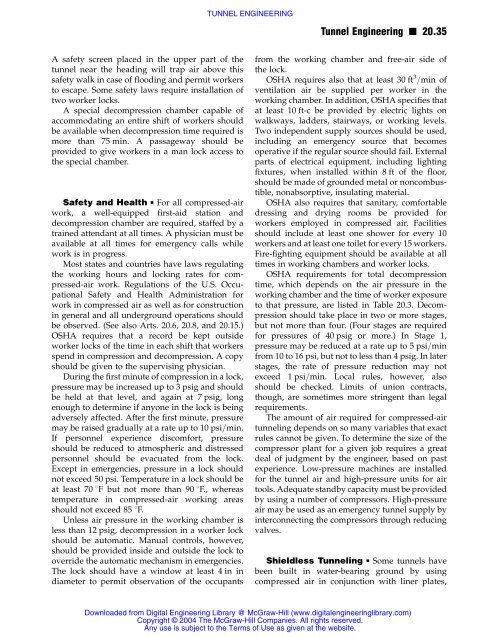TUNNEL ENGINEERING
TUNNEL ENGINEERING
TUNNEL ENGINEERING
You also want an ePaper? Increase the reach of your titles
YUMPU automatically turns print PDFs into web optimized ePapers that Google loves.
A safety screen placed in the upper part of the<br />
tunnel near the heading will trap air above this<br />
safety walk in case of flooding and permit workers<br />
to escape. Some safety laws require installation of<br />
two worker locks.<br />
A special decompression chamber capable of<br />
accommodating an entire shift of workers should<br />
be available when decompression time required is<br />
more than 75 min. A passageway should be<br />
provided to give workers in a man lock access to<br />
the special chamber.<br />
Safety and Health n For all compressed-air<br />
work, a well-equipped first-aid station and<br />
decompression chamber are required, staffed by a<br />
trained attendant at all times. A physician must be<br />
available at all times for emergency calls while<br />
work is in progress.<br />
Most states and countries have laws regulating<br />
the working hours and locking rates for compressed-air<br />
work. Regulations of the U.S. Occupational<br />
Safety and Health Administration for<br />
work in compressed air as well as for construction<br />
in general and all underground operations should<br />
be observed. (See also Arts. 20.6, 20.8, and 20.15.)<br />
OSHA requires that a record be kept outside<br />
worker locks of the time in each shift that workers<br />
spend in compression and decompression. A copy<br />
should be given to the supervising physician.<br />
During the first minute of compression in a lock,<br />
pressure may be increased up to 3 psig and should<br />
be held at that level, and again at 7 psig, long<br />
enough to determine if anyone in the lock is being<br />
adversely affected. After the first minute, pressure<br />
may be raised gradually at a rate up to 10 psi/min.<br />
If personnel experience discomfort, pressure<br />
should be reduced to atmospheric and distressed<br />
personnel should be evacuated from the lock.<br />
Except in emergencies, pressure in a lock should<br />
not exceed 50 psi. Temperature in a lock should be<br />
at least 70 8F but not more than 90 8F., whereas<br />
temperature in compressed-air working areas<br />
should not exceed 85 8F.<br />
Unless air pressure in the working chamber is<br />
less than 12 psig, decompression in a worker lock<br />
should be automatic. Manual controls, however,<br />
should be provided inside and outside the lock to<br />
override the automatic mechanism in emergencies.<br />
The lock should have a window at least 4 in in<br />
diameter to permit observation of the occupants<br />
<strong>TUNNEL</strong> <strong>ENGINEERING</strong><br />
Tunnel Engineering n 20.35<br />
from the working chamber and free-air side of<br />
the lock.<br />
OSHA requires also that at least 30 ft 3 /min of<br />
ventilation air be supplied per worker in the<br />
working chamber. In addition, OSHA specifies that<br />
at least 10 ft-c be provided by electric lights on<br />
walkways, ladders, stairways, or working levels.<br />
Two independent supply sources should be used,<br />
including an emergency source that becomes<br />
operative if the regular source should fail. External<br />
parts of electrical equipment, including lighting<br />
fixtures, when installed within 8 ft of the floor,<br />
should be made of grounded metal or noncombustible,<br />
nonabsorptive, insulating material.<br />
OSHA also requires that sanitary, comfortable<br />
dressing and drying rooms be provided for<br />
workers employed in compressed air. Facilities<br />
should include at least one shower for every 10<br />
workers and at least one toilet for every 15 workers.<br />
Fire-fighting equipment should be available at all<br />
times in working chambers and worker locks.<br />
OSHA requirements for total decompression<br />
time, which depends on the air pressure in the<br />
working chamber and the time of worker exposure<br />
to that pressure, are listed in Table 20.3. Decompression<br />
should take place in two or more stages,<br />
but not more than four. (Four stages are required<br />
for pressures of 40 psig or more.) In Stage 1,<br />
pressure may be reduced at a rate up to 5 psi/min<br />
from 10 to 16 psi, but not to less than 4 psig. In later<br />
stages, the rate of pressure reduction may not<br />
exceed 1 psi/min. Local rules, however, also<br />
should be checked. Limits of union contracts,<br />
though, are sometimes more stringent than legal<br />
requirements.<br />
The amount of air required for compressed-air<br />
tunneling depends on so many variables that exact<br />
rules cannot be given. To determine the size of the<br />
compressor plant for a given job requires a great<br />
deal of judgment by the engineer, based on past<br />
experience. Low-pressure machines are installed<br />
for the tunnel air and high-pressure units for air<br />
tools. Adequate standby capacity must be provided<br />
by using a number of compressors. High-pressure<br />
air may be used as an emergency tunnel supply by<br />
interconnecting the compressors through reducing<br />
valves.<br />
Shieldless Tunneling n Some tunnels have<br />
been built in water-bearing ground by using<br />
compressed air in conjunction with liner plates,<br />
Downloaded from Digital Engineering Library @ McGraw-Hill (www.digitalengineeringlibrary.com)<br />
Copyright © 2004 The McGraw-Hill Companies. All rights reserved.<br />
Any use is subject to the Terms of Use as given at the website.
















